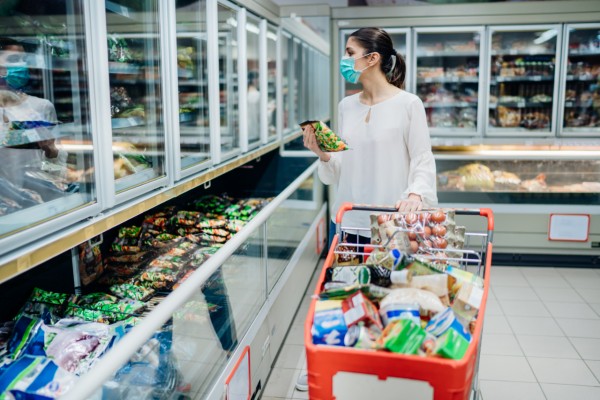
When COVID-19 (also known as coronavirus) first broke, people weren’t sure what it meant yet. But when the President first noted the threat of the coronavirus, and then again when states across the country started leveraging Shelter in Place mandates, consumers jumped. There was a rash of panic buying in cities and states across the country, as people prepared to stay at home for varying, and possibly indefinite amounts of time. The media has been filled with images of empty store shelves, as people stock up on everything, from pantry staples to meat to, of course, toilet paper.
For consumers who weren’t panic-buying and pantry-stocking, this meant low—or no—levels of products on store shelves. For retailers, however, it meant an unexpected increase in sales. According to Nielsen, grocery staples spiked in the four weeks ending on March 7 as compared to the same time in 2019. And that first week of March, Nielsen says, was a particularly high sales time. What were consumers buying to load up their pantries?
- Oat milk—up 347.3 percent
- Dried beans—up 62.9 percent
- Tuna—up 31.2 percent
- Dried milk—up 126.3 percent
- Fresh meat—up 206.4 percent
- Kombucha—up 10.1 percent
Currently, 21 states are under statewide order to stay home, and their residents are cautioned to support essential businesses—grocery stores, pharmacies, and go outside for fresh air—sparingly. Consequently, this has changed both the way people are shopping, and the way grocers are doing business.
Consumers are staying home, but still need to eat
For consumers, it means they’re not shopping as frequently. “As millions of U.S. consumers stocked up on essentials to prepare for long stretches of time at home to slow the spread of coronavirus, Nielsen statistics show a lot of them bought food that will sustain them for the long haul,” writes Megan Poinski for Food Dive.
And when they do need groceries, many consumers are turning to grocery delivery apps, rather than head to the stores themselves. As of March 15, daily downloads of some of the most popular grocery delivery apps had surged to unprecedented levels over the previous month: Instacart saw a 218 percent increase, Walmart Grocery a 160 percent increase, and Shipt a 124 percent increase. And in turn, companies like Instacart are quickly hiring massive amounts of new employees to keep the orders rolling.
Whether consumers are shopping in stores themselves, or having someone do it for them, there is still the issue of retailers having the supply to meet the demand. After multiple rounds of panic-buying and pantry-stocking, the supply chain is struggling in some instances to keep up, as retailers hustle to fill shelves.
What about when it’s not only the grocery shelves that are empty but also the warehouses? Retailers can’t stock what they don’t have, and the supply chain goes many levels deeper than their own warehouses. To counteract the diminished amounts of products, many retailers are turning to RangeMe and online product discovery to help them fill their gaps, from canned goods to cleaning supplies. They’re able to view profiles, request samples, and view digital sell sheets to source brands that have drop ship capabilities and are able to support the retail customers’ needs. Emerging brands have been playing an increasing role in keeping grocery retail humming as the COVID-19 pandemic keeps on, particularly those that provide household essentials, or cleaning and disinfecting supplies as customers are more willing to try a brand they are not so familiar with yet.
Into unknown times
The U.S. is in the midst of a pandemic, and there is no certainty to when it will end. That uncertainty is charging consumers to change their usual shopping behavior, and retailers are adjusting as well.“It’s a fluid time, and retailers are balancing between keeping enough of the most sought-after supplies on their shelves while making contingency plans for longer-term gaps in their product portfolios,” wrote Nielsen in early March. That fluidity doesn’t appear to be stopping anytime soon, as consumers shop in bursts, and sales of pantry and home essentials continue to rise. But as challenging as these times are, retailers are dedicated to providing consumers with the products they need, and RangeMe is helping them fulfill on that assurance.

